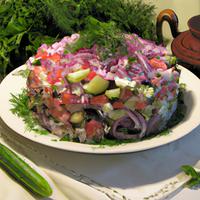
1 serving (150 grams) contains 200 calories, 3.0 grams of protein, 12.0 grams of fat, and 15.0 grams of carbohydrates.

Log this food in SnapCalorie

Nutrition Information
Calories |
315.5 | ||
|---|---|---|---|
% Daily Value* |
|||
| Total Fat | 18.9 g | 24% | |
| Saturated Fat | 3.2 g | 16% | |
| Polyunsaturated Fat | 0 g | ||
| Cholesterol | 15.8 mg | 5% | |
| Sodium | 630.9 mg | 27% | |
| Total Carbohydrates | 23.7 g | 8% | |
| Dietary Fiber | 3.2 g | 11% | |
| Sugars | 4.7 g | ||
| protein | 4.7 g | 9% | |
| Vitamin D | 0 mcg | 0% | |
| Calcium | 47.3 mg | 3% | |
| Iron | 0.8 mg | 4% | |
| Potassium | 315.5 mg | 6% | |
* Percent Daily Values are based on a 2,000 calorie diet. Your daily values may be higher or lower depending on your calorie needs.
Food Attributes
Source of Calories
About Insalata russa
Insalata Russa, also known as Russian Salad, is a classic dish with roots in Eastern European cuisine, particularly popular in Italy and France. Traditionally served cold, it consists of diced boiled potatoes, carrots, green peas, and sometimes other vegetables like cucumbers or pickles. These are mixed with mayonnaise to create a creamy texture and rich flavor. Some variations include diced boiled eggs, meats like ham or chicken, or seafood for added protein. While Insalata Russa is a colorful and nutrient-dense dish due to the variety of vegetables it contains, the mayonnaise can be high in calories and fats, making moderation key for those watching their intake. To make it lighter, low-fat or yogurt-based alternatives can be substituted for traditional mayonnaise. It’s a versatile dish often enjoyed as an appetizer or side, offering both indulgence and nutrition depending on its preparation.



